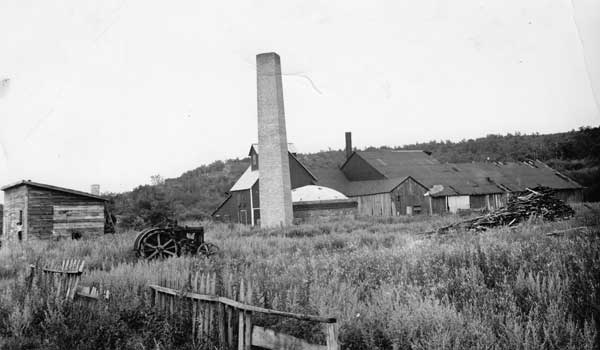|

The Leary Brickworks (late 1940s)
Source: Ina Bramadat
Leary Brickworks is typical of similar small industries located in rural Manitoba that catered to local markets. First established about the turn of the century, the brickworks at Learys operated almost exclusively as a family-owned firm. Located along the steep, wooded banks of the South Boyne River on the eastern slopes of the Pembina Hills, the site is blessed with accessible deposits of shale.
George Leary originally recognized the potential for a brickworks and invested in the construction of a plant. Known as the Boyne Brick Works, it operated briefly before the company was reorganized as the Dominion Press Brick Company. In 1910, Leary regained control of the firm and operated it as the Leary Brickworks until a general shutdown in 1917. The plant was idle until 1948 when George’s son, William, reopened the works. William’s death in 1951 resulted in the sale of the site to E. Talman in the following year. Inexperienced in brick making, Talman was unable to produce useable bricks and he re-sold the mill to the Learys.
George Leary, on left, supervising the dismantling of one of the temporary kilns at the site. Used for making common brick in small quantities, this labourious and comparatively inefficient firing method was abandoned after the construction of the present kiln.
Source: Ina Bramadat
The shale, exposed on the hillside by a cultivator, was sun-dried. Wheelbarrows, and later a tractor, hauled the dried shale to the crusher in the mill. The finely crushed material was elevated to the top of the mill where it was screened and mixed into a clay. This clay was fed to the press where the bricks, up to 12,000 per day, were produced. The 80,000-brick kiln was filled and fired for several days. Three batches of bricks were fired each summer.
Leary Brickworks was part of the diversified rural economy which characterized the early period of prairie settlement. Its failure was due to the concentrating effects of corporate capital investment in industry and transportation.
Abandoned brick mill at the Leary Brickworks, August 1989. The Learys hope to develop the mill and kiln as a working heritage site.
Source: David Neufeld
Map of the Leary Brickworks site (1989)
Source: David Neufeld
See also:
Historic Sites of Manitoba: Leary Brickworks (Learys, Municipality of Lorne)
Page revised: 26 February 2022